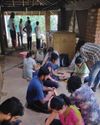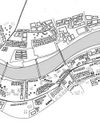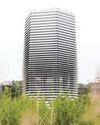Sound in schools is damaging millions of children’s health and education. Architects have the power to change this.

Architectural design decisions influence how productive and healthy our schools are. Many architects will know, for example, that good natural light can improve learning and health (Loisos, 1999). Sound has an equally powerful effect on educational outcomes and health, and yet this crucial environmental factor is largely ignored by architects.
Noise in schools has been a recognised problem for over 100 years (Canning & James, 2012). Study upon study has revealed unbearably noisy classrooms and poor acoustic conditions. Indeed, experts state that poor classroom acoustics are the number one overlooked problem in schools (Harmel, 2000). Noise is schools is an epidemic, and it’s hurting our children and teachers in three serious ways.
Speech intelligibility
Sound matters fundamentally, because pupils must be able to hear their teacher in order to learn. When noise levels are too high, often because classrooms are too reverberant, pupils find it hard to understand their teachers.
If education is like watering a garden, much of the water is evaporating before it even reaches the plants. Pupils on the back row of a traditional classroom hear just 50% of the teacher’s words (Siebein, cited in Harmel, 2000; Leavitt & Flexer, 1991). This affects young children in particular, who have great difficulty understanding speech even with low levels of noise (Elliott et al., 1979; Neuman & Hochberg, 1983).
Cognition
Noise disrupts cognition, so even if the students can hear the teacher, their work is adversely affected. Noise compromises many tasks, including memory, motivation, reading, mental arithmetic, and problem solving (Cohen, Evans, Krantz, & Stokols, 1980; Evans, Hygge, & Bullinger, 1995; Jones, 2010).
この記事は Indian Architect & Builder の May 2018 版に掲載されています。
7 日間の Magzter GOLD 無料トライアルを開始して、何千もの厳選されたプレミアム ストーリー、9,000 以上の雑誌や新聞にアクセスしてください。
すでに購読者です ? サインイン
この記事は Indian Architect & Builder の May 2018 版に掲載されています。
7 日間の Magzter GOLD 無料トライアルを開始して、何千もの厳選されたプレミアム ストーリー、9,000 以上の雑誌や新聞にアクセスしてください。
すでに購読者です? サインイン

Interlacing Perspectives
‘Meraki-2019’ A visionary Seminar series presented by Dr.Baliram Hiray College of Architecture, Bandra(East), Mumbai.

Facilitating A Community Through Architectural Practice
The humble, self-designed, self-built and organically planned home built by the majority of the world population rarely gets appreciated and critiqued as a viable lesson in architectural design.

The Art Of Solving Problems Creatively
The practice of architecture is perhaps incomplete without the complement of a variety of other arts.

Upcycling towards a playful tomorrow
Play is like the middle child, often forgotten, and always taking a back seat. For young kids, play can simply be running around, armwrestling with friends, building sandcastles on the beach, or singing popular music tracks in the shower.

Balancing The Poetics And Pragmatism Of Everyday Design
Humanity is faced with an oxymoronic crisis. The crisis involves the earth, the environment, impending looms of climate change, deforestation, loss of species, dwindling resources etc.

Just Give Me Some Space: Discussions And Beyond
Just Give Me Some Space (JGMSS) is Suha Riyaz Khopatkar’s debut book that paints a portrait of the dynamic life of an architecture student.

The Next In Vernacular Architecture
Architecture has become a capitalist.

Rethinking The Future: Architecture And Its Education
“I want to be like animals, the bird makes a nest in one or two days, the rat digs a hole in a night, but intelligent humans like us spend 30 years to have a house, that’s wrong.” - Jon Jandai

Uniting The Human-Scale With The City-Scale
London-based architect Usman Haque is famed for his interactive architectural systems, and for his exploration of newer, more effective ways of creating human engagement and interaction through his designs. Indian Architect & Builder caught up with him, to quiz him on a variety of topics such as his journey as an architect, his inspirations and philosophies, architects using the digital revolution to their advantage, and more!

Framing spaces
Almost every architect also doubles as a photographer or at least an enthusiast.